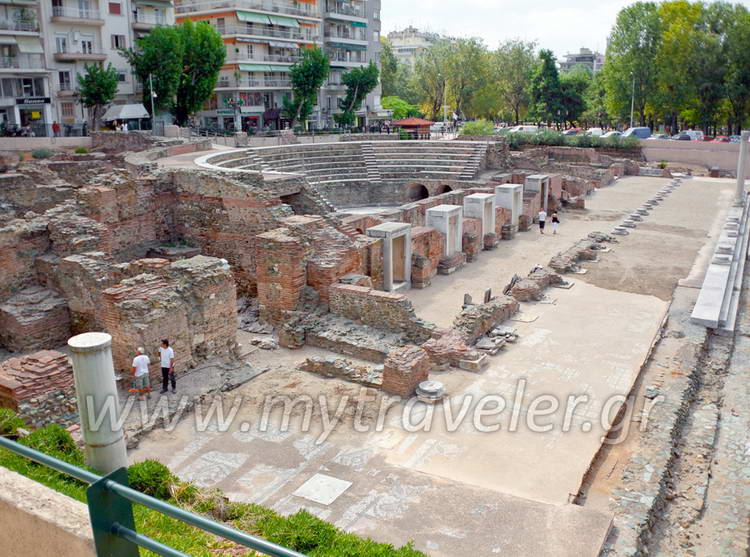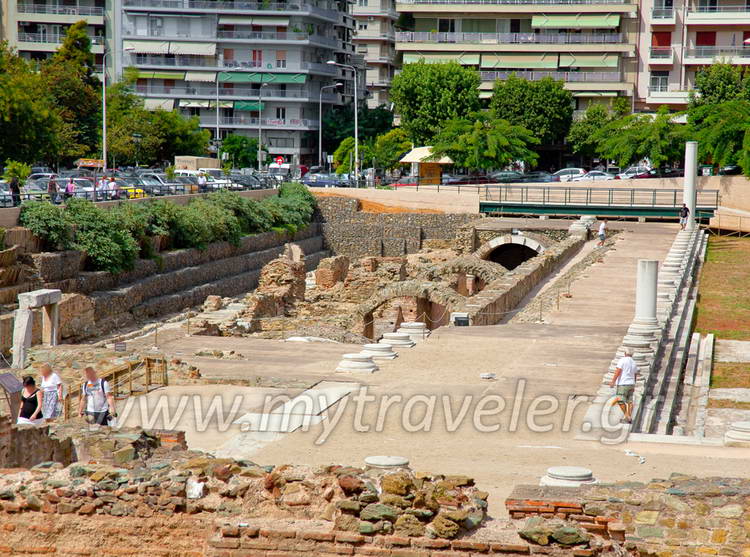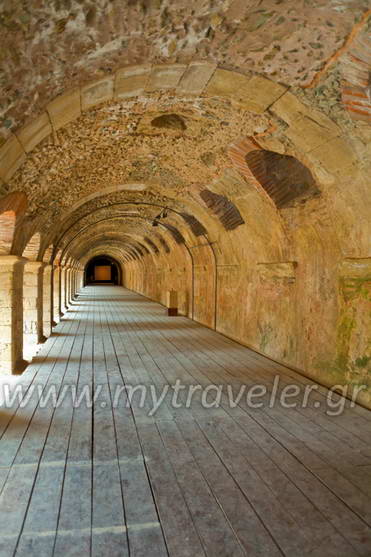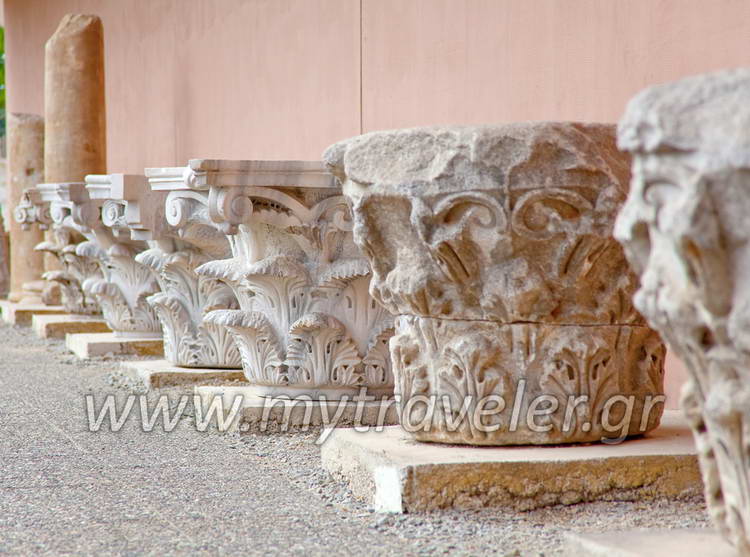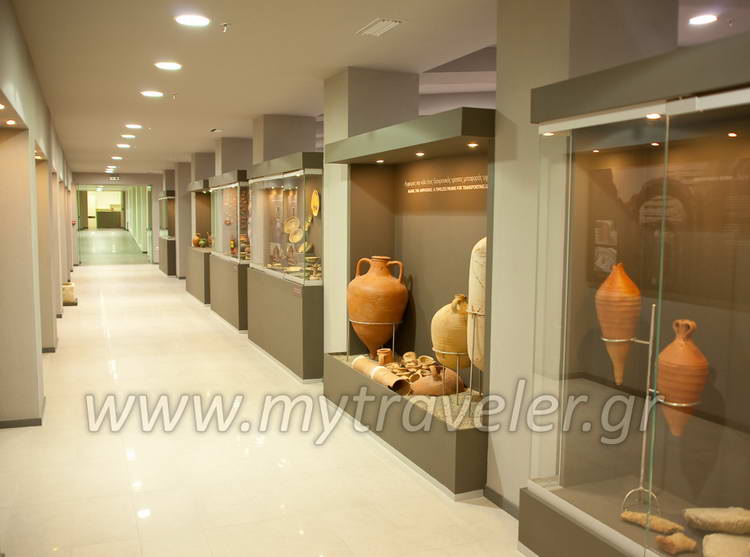Description
The first use of the archaeological site of ancient Agora is dated up to Hellenistic times. According to the latest data it has been confirmed that the site was used in the last quarter of the third century until after the mid-2nd century BC, when workshops were founded with dug clay pits, for pottery and figurines.
Of particular interest is the south-east sector, which essentially lies outside the Agora complex. Here the space also began to be used around the late 3rd or early 2nd century, when large clay pits were dug and filled in soon afterwards, followed by construction phases in the 2nd century BC approximately until the time of Augustus. One distinctive structure in this sector is part of a balneary, with two rooms (one round sweat-room and one rectangular room with two storeys), two pools, one cold and one hot ,and the furnace on the south side. The balneary complex has been built in the Late Hellenistic period (2nd cent. BC) and survived until the Vespasian's time (78 AD). The site was raised in the 2nd century, and when the Agora complex was built, rectangular structures (possibly shops belonging to a smaller commercial Agora or market) were erected along the street directly to the south, and this remained in use until the Early Christian period.
The stratigraphy of the east wing showed at least seven main phases. Before the public buildings of the imperial period were constructed, there seem to be two phases in the east wing. The first, without building remains dates to the late 3rd and early 2nd century BC, when clay pits were dug and later filled in. The second dates around the mid 2nd century BC, when private houses were built and remained standing until about 1st century AD.
In the 1st century AD the site was turned over to public use. An agora was created with rooms on either side of the rectangular bouleuterion. After the mid-2nd century, it was decided to erect an Odeon on the site of the bouleuterion, and two lateral areas of the bouleuterion were retained to serve as paraskenia.
This 2nd century Odeon, with seating for 200 viewers, was enlarged to a capacity of 400 after the middle of the 3rd century to serve the need of what Lucian describes as a large and populous city. This building in the 4th c. AD began to be transformed to an open air theater, an effort which was never fulfilled. An important building which is connected with the administrative function of the Agora complex is the southernmost chamber, which was one of the city's archives.
The Agora in a shape of a double L was open to the north (Olympou str.) overing about 20 hectares. Around a rectangular marble-paved square, three double stoas with Corinthian columns was in front of each wing, where there were all public services (mint, archives, justice court etc) of the city, capital of the Province of Macedonia. To the south (Filippou str.) the wing stand on a double underground stoa (Cryptoporticus). To the south of the cryptoporticus is a row of twenty shops open to a, two and a half meters wide, marble- paved street. This great complex was not only an administrative centre but also here gathered all the citizens and the visitors of the city. In the 5th century the Agora was abandoned and in the square reappear pottery activities with new clay pits. Only the use of the shops continued till 13th-14th c.AD. After the 5th century AD the Cryptoporticus was transformed to a cistern.
admission free
Visiting hours:
Daily 8.30-15.00
Monday closed
Of particular interest is the south-east sector, which essentially lies outside the Agora complex. Here the space also began to be used around the late 3rd or early 2nd century, when large clay pits were dug and filled in soon afterwards, followed by construction phases in the 2nd century BC approximately until the time of Augustus. One distinctive structure in this sector is part of a balneary, with two rooms (one round sweat-room and one rectangular room with two storeys), two pools, one cold and one hot ,and the furnace on the south side. The balneary complex has been built in the Late Hellenistic period (2nd cent. BC) and survived until the Vespasian's time (78 AD). The site was raised in the 2nd century, and when the Agora complex was built, rectangular structures (possibly shops belonging to a smaller commercial Agora or market) were erected along the street directly to the south, and this remained in use until the Early Christian period.
The stratigraphy of the east wing showed at least seven main phases. Before the public buildings of the imperial period were constructed, there seem to be two phases in the east wing. The first, without building remains dates to the late 3rd and early 2nd century BC, when clay pits were dug and later filled in. The second dates around the mid 2nd century BC, when private houses were built and remained standing until about 1st century AD.
In the 1st century AD the site was turned over to public use. An agora was created with rooms on either side of the rectangular bouleuterion. After the mid-2nd century, it was decided to erect an Odeon on the site of the bouleuterion, and two lateral areas of the bouleuterion were retained to serve as paraskenia.
This 2nd century Odeon, with seating for 200 viewers, was enlarged to a capacity of 400 after the middle of the 3rd century to serve the need of what Lucian describes as a large and populous city. This building in the 4th c. AD began to be transformed to an open air theater, an effort which was never fulfilled. An important building which is connected with the administrative function of the Agora complex is the southernmost chamber, which was one of the city's archives.
The Agora in a shape of a double L was open to the north (Olympou str.) overing about 20 hectares. Around a rectangular marble-paved square, three double stoas with Corinthian columns was in front of each wing, where there were all public services (mint, archives, justice court etc) of the city, capital of the Province of Macedonia. To the south (Filippou str.) the wing stand on a double underground stoa (Cryptoporticus). To the south of the cryptoporticus is a row of twenty shops open to a, two and a half meters wide, marble- paved street. This great complex was not only an administrative centre but also here gathered all the citizens and the visitors of the city. In the 5th century the Agora was abandoned and in the square reappear pottery activities with new clay pits. Only the use of the shops continued till 13th-14th c.AD. After the 5th century AD the Cryptoporticus was transformed to a cistern.
admission free
Visiting hours:
Daily 8.30-15.00
Monday closed
Published: 1 Jun. 2010
Add to favorite
- Information -
| GPS Coordinates |
| 40.637871 , 22.945889 |
| 40° 38' 16,3356"N , 22° 56' 45,2004"E |
Where to stay
accommodations located nearby
More Holiday Ideas
what else you can see here around
